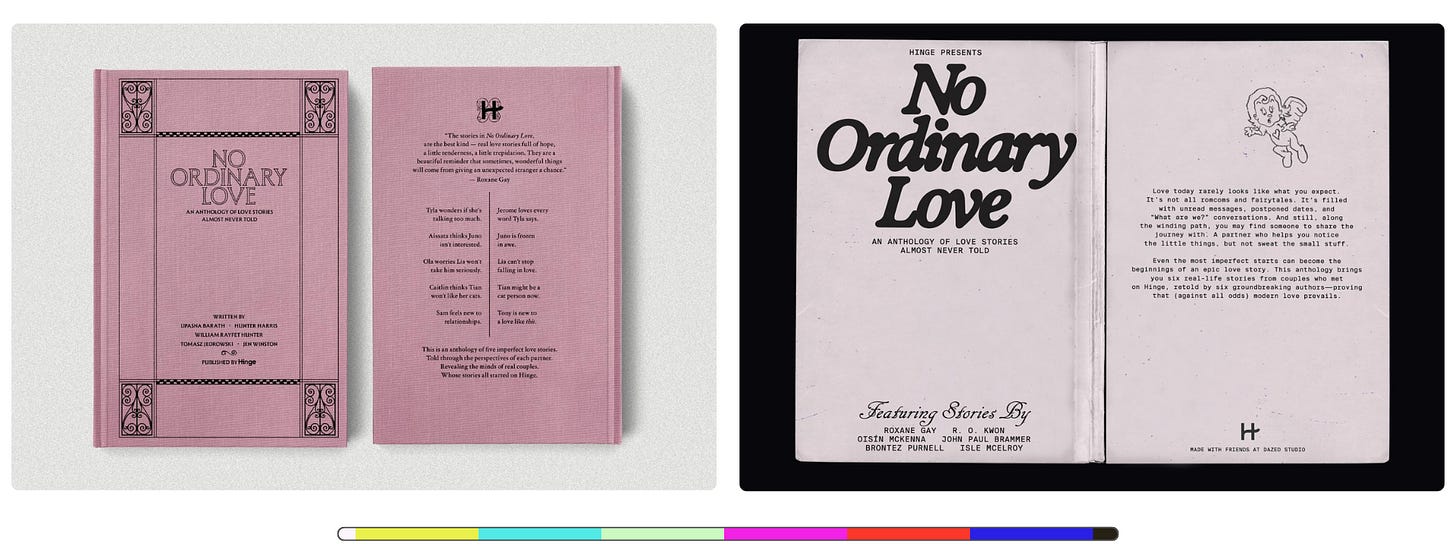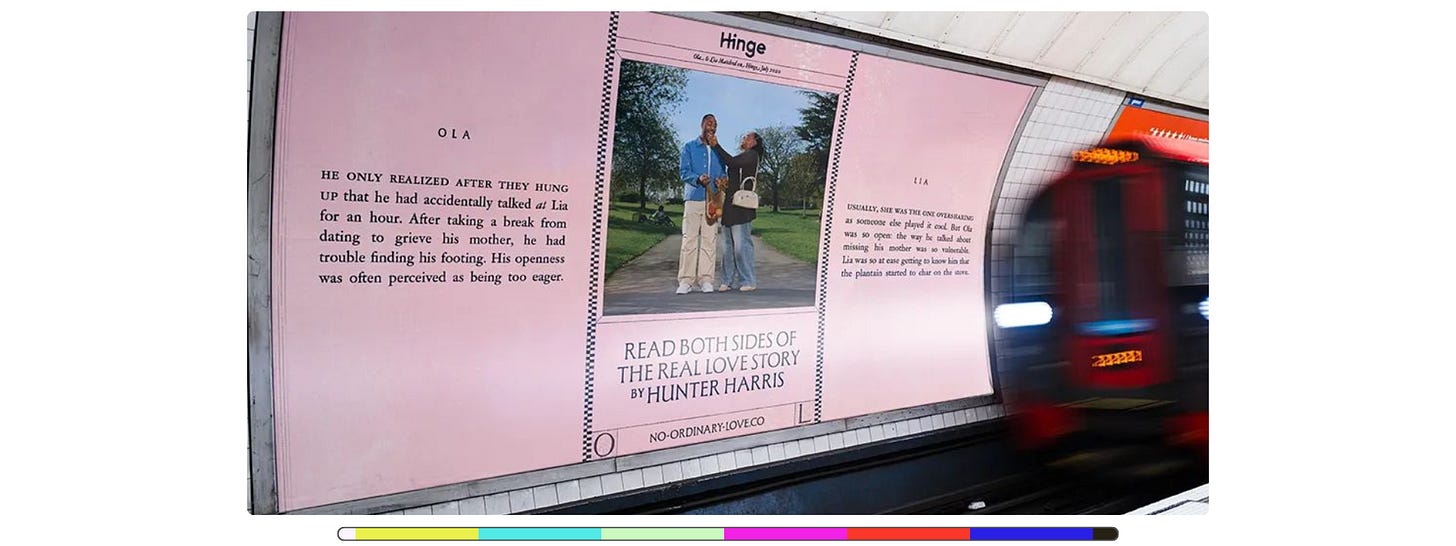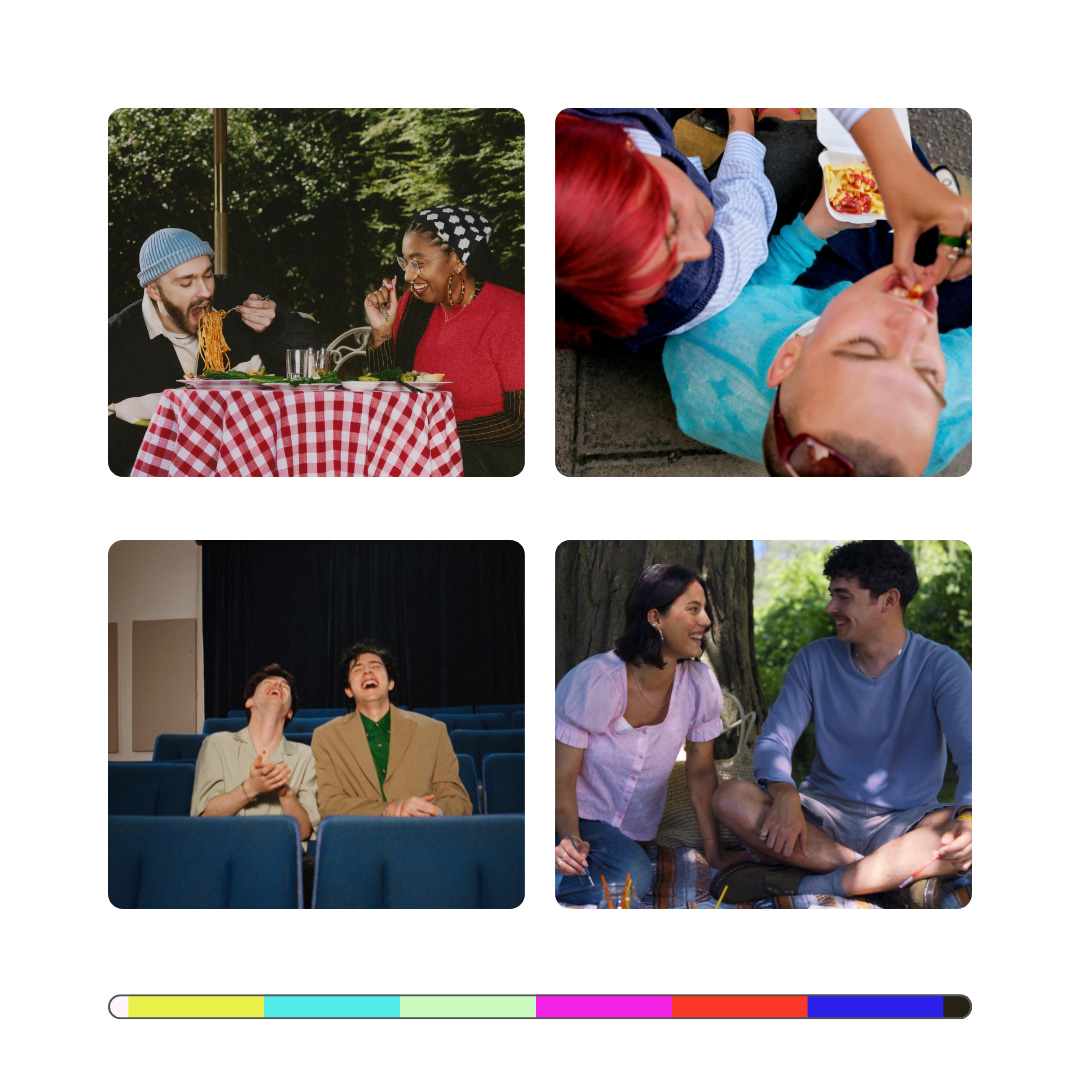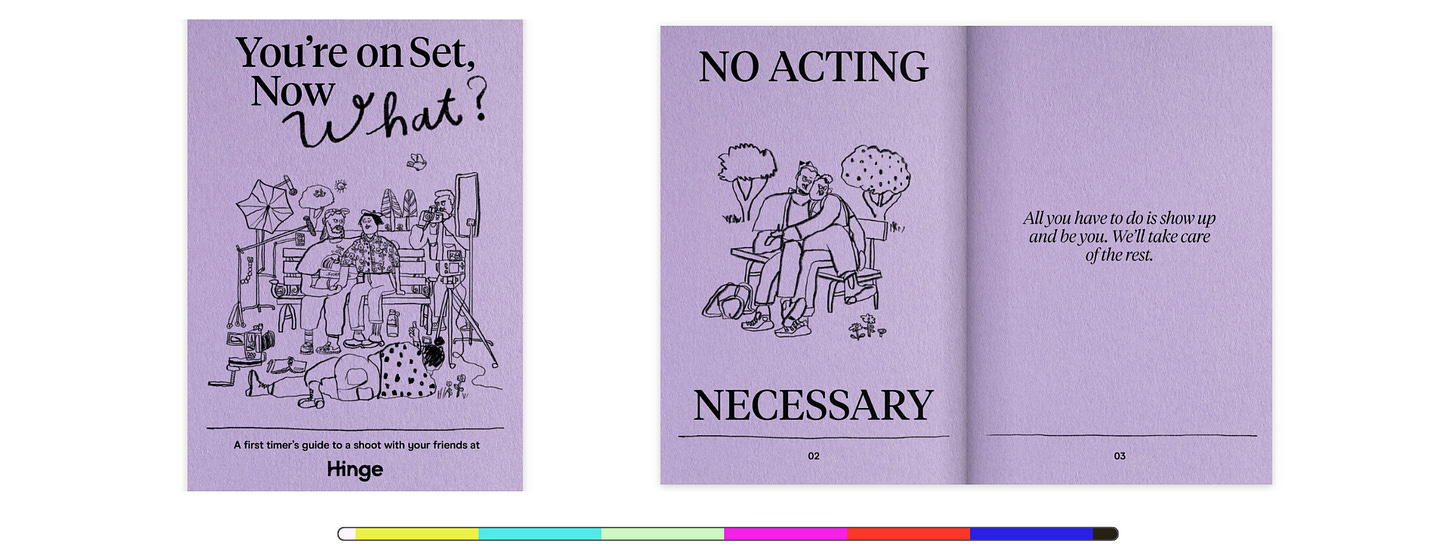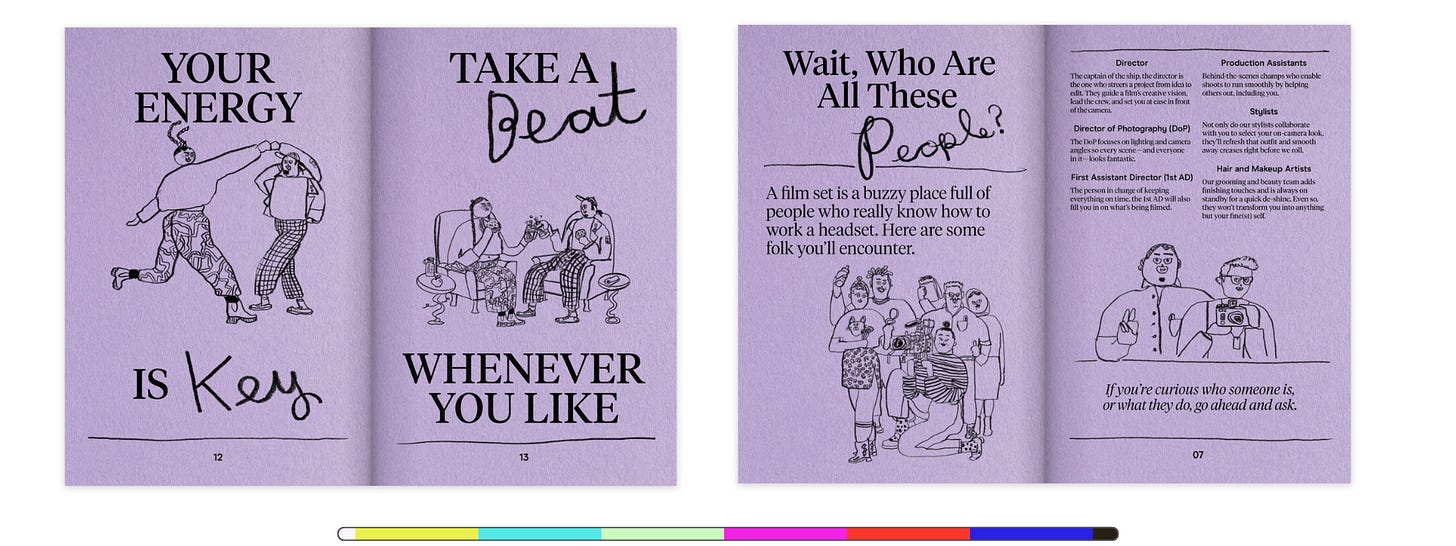Not Unhinged
· 'Designed to be deleted' · Why Do It? · Verts · Social simulation collapse ·
~ of dating, ESPN, Nike, Call of Duty, Madonna & social media collapse. ~
🎧 Prefer to listen? Hit play above to listen to me read this week’s dispatch.
Hinged: “designed to be deleted” is the line for dating app Hinge, a bold claim in times when ‘in-app retention’ is so dominant. I look at a couple of content initiatives from the matchmaker, embracing that ethos.
Curated/Cuts: Another swaggeringly glib spot from Nike (Why Do It?), and a gentler one from the New York Times.
ESPN Verts: Vertical vids in ESPN’s new streaming service- nice quickies or yet another doomscrolling window?
Social maze: Scientists created a simulated social media network with AI bots. The results were not great.
+ Movement in video game adaptations, Madonna’s 90s album resurgent, and Anthropic’s Claude has to pay around $1.5B in settlements.
Hinged
Those who know me know I don’t have much experience with dating apps, thank you very much. Yet some efforts from Hinge have caught my eye. They seem to lean into a simple idea which is lost in the pow-wow of digital matchmaking- dating apps shouldn’t feel like an endless scroll of profiles, but be the beginnings of real relationships.
Hinge grounds this in real, lived experiences, manifested in meaningful, creative expressions.
‘No Ordinary Love’ is a literary experiment with Dazed Studio, where Hinge commissioned five contemporary writers to tell the stories of real couples, but from dual perspectives. Each appeared weekly on Substack before being gathered in a charming cloth-bound book; the feel is classic, intimate. There were book clubs and OOH in NYC and London and tie-ins with BookTok and Substack creators. The physical manifestation stood out for me- tangible ways to turn in-app collisions into something meaningful in the real world.
Once I looked, I also found ‘It’s Funny, We Met on Hinge’, a series of shorts spotlighting couples whose paths zigzagged between real life and the app. Some spotted each other on trains, or at Pride events, before matching on the app; others had mutual friends but never quite crossed paths until the app brought them together.
These narratives blur the line between chance encounters and the algorithm. Contemporary romance isn’t either ‘in real life’ or ‘online’, but usually a messy, overlapping mix. Hinge looks to place itself in that blur, part of a wider, unpredictable fabric of modern dating.
The campaigns build on 2024 efforts: No Ordinary Love began as a zine anthology, the It’s Funny films focused on couples who had almost—but not quite—met before Hinge. It all gives off this vibe of being real, textured, rooted in real worlds, and real digital worlds.
This happy melange of stories, screens, substacks and serendipity makes Hinge’s “designed to be deleted” ethos feel like more than just a clever marketing line.
Both chapters of It’s Funny We Met were developed with Birthday and directed by India Sleem.
Addendum: Feeling Good
In a lovely peek into the approach to production and to the couples, I found that Hinge created a 20-page printed zine titled You’re on Set, Now What? to help the featured couples get a sense of what the experience will be like. With simple but key details to help them prepare, it showed a lovely touch, welcoming regular folk who may not be familiar with a film set, and who definitely will find it a challenge to open up on camera.
“It’s a real privilege to share the love stories of real Hinge couples with the world. We think a lot about the creative tension in asking our courageous couples to reflect on their personal journeys while being surrounded by lights, cameras, and the thrilling organized chaos of a set. We’re intentional about creating an environment where people feel safe, seen, and entirely themselves.” _Ola Sobiecki, VP & ECD at Hinge.
The zine was illustrated by Tara Booth.
🎬 Curated/Cuts.
1. Its Your World
The New York Times has a new spot out. With ‘It’s your world to understand’, they want us to go along on our journey because it is “Your day. Your place. Your life.” This frames the NYT as a daily companion, not just a premier news publisher; which of course is already evident in how much they are interwoven with their users’s lives with games, food, lifestyle and more.
I like the simplicity, the diversity, the warmth, and the curiosity. Much of that will hit home with repeated viewings- that can be a good thing.
2. Why Do It?
You can count on Nike to be glib. Paired with Tyler, the Creator, they launch another bold, swaggering spot, ‘Why Do It?’
Framed as reintroducing a new generation to ‘Just Do It’, it pushes those on the brink of action to make the choice, take the plunge…. and do it. Nike still ensures it finds its way back to the motif of winning, always having the chance to come out on top.
➕ Some quick hits:
All-in on game adaptions. The ‘new’ Paramount is making Call of Duty. And has a new deal for Street Fighter. There’s a good debate happening here about whether the CoD movie is going to a runaway smash hit, or a middling success with little chance of ultra wide resonance.
Tomb Raider: Still with games, the new Lara Croft series- cooking for some time- is now officially moving ahead on Amazon Prime Video, with
Sansa Stark Jean GreySophie Turner playing the titular character, in a show written by Phoebe Waller Bridge.“The album was such a cultural disruptor when it came out, it retains a rare cachet more than 27 years later.” Why Madonna's Ray of Light is 2025's hottest album looks at how many of today's hottest pop stars are taking inspiration from Madonna's swirling 1998 masterpiece.
In case you missed it, Anthropic (maker of Claude AI) has agreed to pay $1.5 billion to settle with authors who accused it of illegally downloading copyrighted books to train its AI models. OpenAI, Midjourney, Meta and most recently Apple are all looking at similar class action complaints.
Shoutout:
I also craft eclectic & curious storytelling on 'Coffee & Conversations'. An example? I recently dived into the fascinating story of how our calendar lost time in 'The Lost Days: the 1582 Adjustment'.ESPN Verts
ESPN Verts is a feature within the ESPN app. It delivers a TikTok-style, vertical video feed of sports highlights, news, viral moments, and social content.
Early reaction, inevitably, suggest some appreciation for quick access and integration, coupled with some ambivalence/scepticism about the industry-wide TikTokification of video- yet another doomscroll.
To refresh, ESPN’s live sports streaming service launched late August, with all 12 of the network’s linear channels within the app, costing $29.99/ month in the US.
Some wonder if the term ‘Verts’ is a good idea, and if it might actually catch on in widespread use. I felt Youtube’s 'Shorts' is probably most primed to become widespread as a generic term, especially as even Tiktok begins to offer landscape mode!
As an aside, this from Tubular/ and The Measure offers an interesting lens on short content for ESPN just leading up to this launch.
In July, 66% of ESPN’s uploads were less than a minute. Views came overwhelmingly from Shorts, but their average minutes watched per unique viewer was a mere six minutes (lowest in the top 100 U.S. media & entertainment).
Social Media Simulation
Two scientists wanted to understand what fuels some of the worst elements of social media- extreme content, echo chambers, attention inequality. So they set about simulating a network, creating AI personas to carry out social media behaviour. The results were, shall we say, less than encouraging.
“The dynamics that give rise to all those negative outcomes are structurally embedded in the very architecture of social media. So we're probably doomed to endless toxic feedback loops unless someone hits upon a brilliant fundamental redesign that manages to change those dynamics.” from Ars Technica .
Jennifer Ouellette spoke to study co-author Petter Tornberg here, who says, “The definition of an online social network is that you have this kind of posting, reposting, and following dynamics. It's quite fundamental to it. That alone seems to be enough to drive these negative outcomes.”
Despite interventions, the simulation could not see any of the less desirable outcomes mitigated in any meaningful way. Victor Tangermann at Futurism says, “It's a sobering reality that flies in the face of companies' promises of constructing a "digital town square" where everybody coexists peacefully.”




